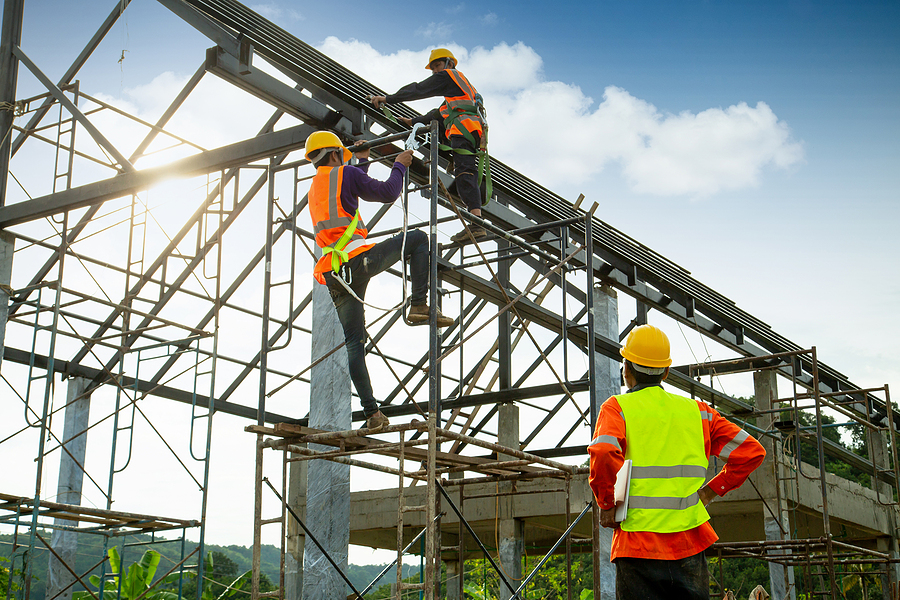OSHA Fall Workplace Compliance Best Practices

Because of the confusion that OSHA fall protection standards and regulations can cause, many site managers don’t fully understand how to ensure their workplaces are compliant, and don’t take the time to fully understand their responsibilities. This leads to violation citations, a major fine and a requirement to resolve the issues promptly. Most common OSHA-compliant safety equipment includes:
Safety Harness with Lanyard
You can find an outline of OSHA-compliant fall protection equipment in 29 CFR 1926.502(d). This includes information on personal fall arrest systems, such as safety harnesses with lanyard. If you are considering this system, ensure you verify that it:
- Adheres to the maximum force limit of the fall arrest on the worker to 1,800 pounds
- Ensures the maximum distance a worker can free fall is 6 feet
- Limits the deceleration distance of a falling worker to no more than 3.5 feet
- Does not meet any lower surface
- Is inspected prior to each use for damage, deterioration, and wear
- Allows a falling worker to come to a complete stop
- Facilitates the arrest of a fall clear of the falling workers chin or neck
A safety harness with lanyard should provide a comfortable fit, with the lanyard positioned in the middle of the worker’s back for attachment. This equally distributes the force through the safety harness, thereby complying with the OSHA’s standard requirement that the harness must not contact the worker’s neck or chin.
The lanyards that can be used in a fall arrest system are also regulated by OSHA. They must be manufactured from synthetic fibers because these are generally stronger than natural fibers. They must also include automatic closing and locking, together with double-action snap hooks to reduce the risk of slipping out of the harness during a fall.
There are two types of harness lanyards: shock-absorbing and non-shock-absorbing. Shock-absorbing lanyards tend to provide the best comfort, safety and reliability for workers who are using a safety harness with lanyard fall protection system, but both are compliant with OSHA standards.
Safety Gates
When dealing with elevated working or walking systems, safety gates are an excellent prevention system. Safety gates must either swing away or slide away from the opening and be self-closing.
This is to prevent someone accidentally walking through the gate, or from opening the gate. There are some cases in which it is necessary for gates to swing toward the opening, and in those cases, safety gates must include a latch that can be released.
In many circumstances, the use of a safety gate is mandatory and required by OSHA. These include:
Roof Openings where a guardrail system is required. Like work platforms, safe access to the roofing area is given with the use of the safety gate. This also helps prevent roof opening falls.
Work Platforms Any work platform requires a guardrail system including mezzanines, standard platforms and loading gates. Using a safety gate provides access to the platform through the guardrail system, but also helps prevent falls from a work platform. The guardrail system is an OSHA requirement.
Ladderways must be protected by a safety gate to prevent a worker falling through a floor hole of a ladderway. All points of access to ladders must be protected.
Any surface greater than 4 feet high has an OSHA requirement that includes a guardrail system. While 4 feet may not sound much, a fall from that height could be dangerous. A safety gate is also required which provides access to the surface, while also helping to prevent falls.
The best option to ensure OSHA compliance is an industrial swing gate. This includes for construction sites, manufacturing facilities and warehouses. There are a variety of styles of industrial swing gate available to suit the conditions you have. These include:
Standard swinging safety gates for use on platforms, ladderways and stairs.
Vertical lift gates for counter-balanced lifts and loading docks.
Pivoting gates that are ideal for use on mezzanines.
Industrial swing gates are also available in a variety of materials, depending on your usage situation.
These materials may include:
- Aluminum
- Carbon steel
- Stainless steel
OSHA also requires that each gate has a smooth surface to prevent injury to workers or snagging of clothing. A coating added to any high-quality industrial swing gate will ensure the metal surface meets these standards.
For further information on affordable fall protection systems, implementation, and OSHA compliance, avoid violations and hefty fines by contacting Safety Counselling today!
